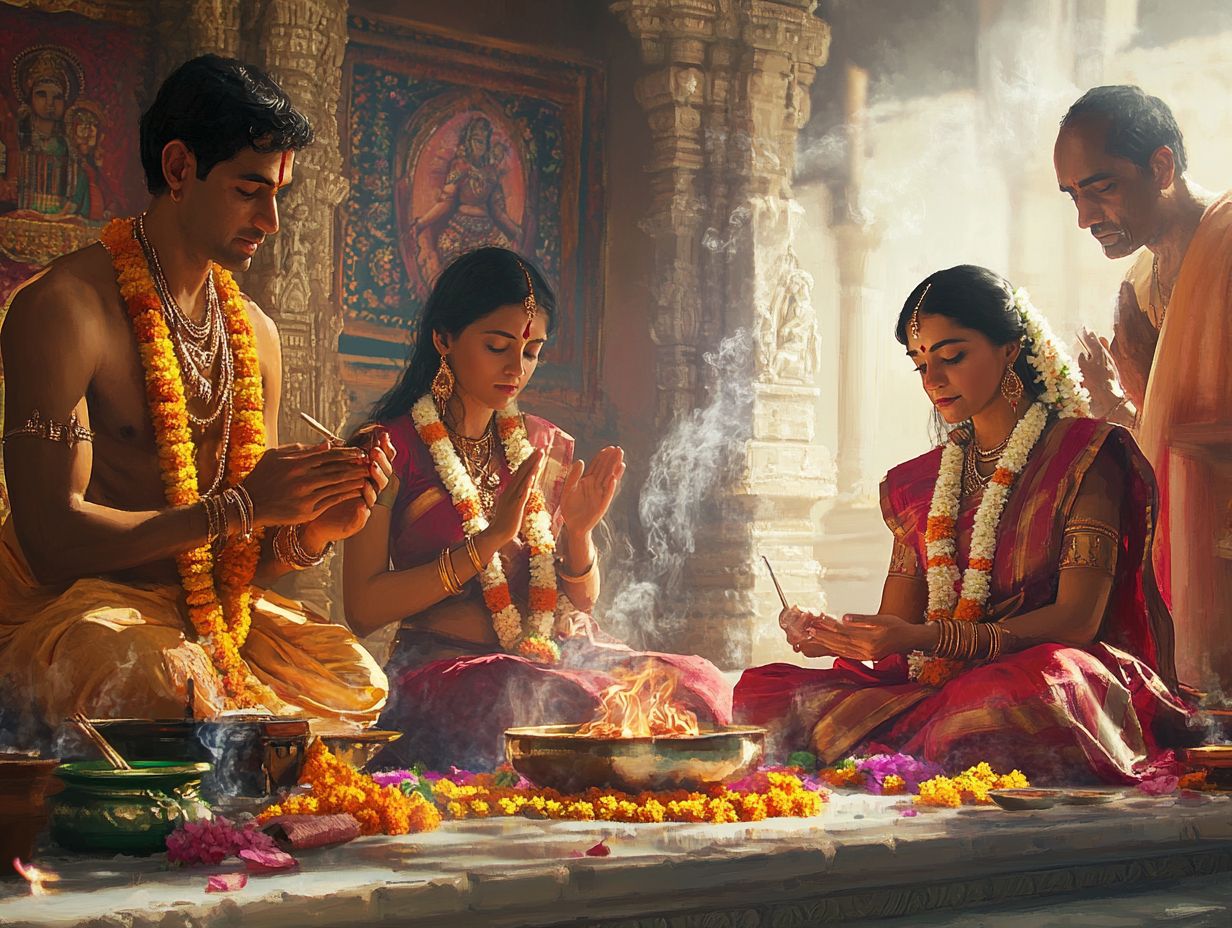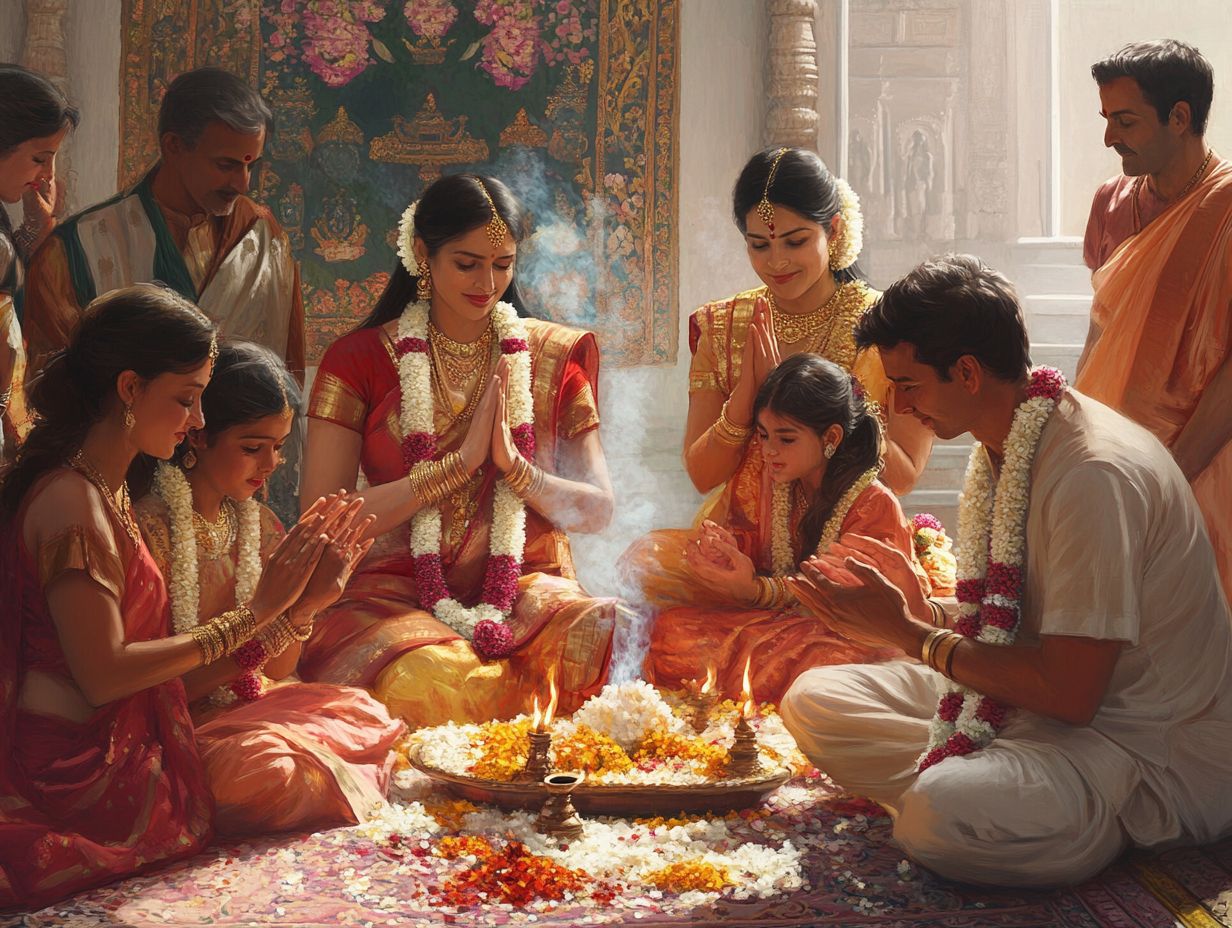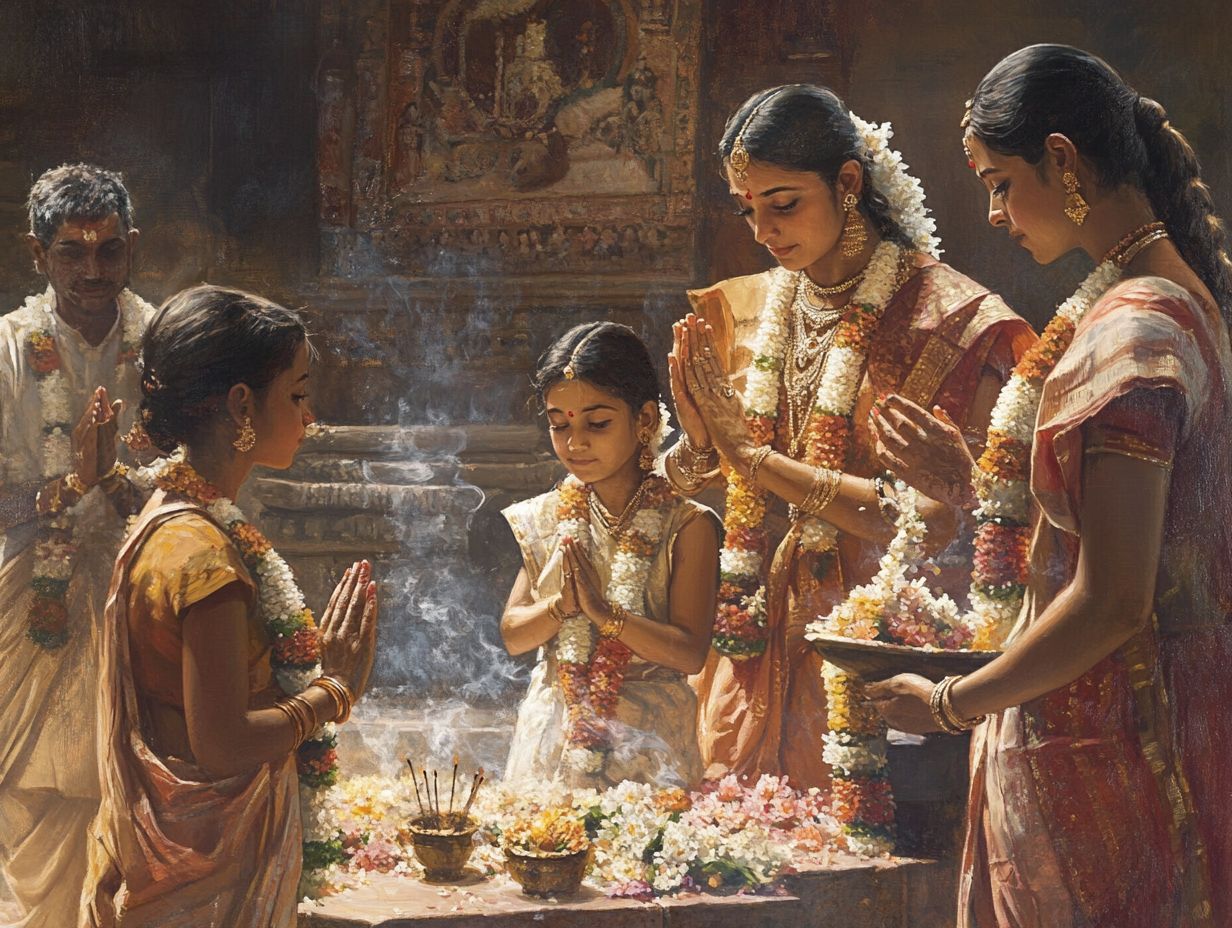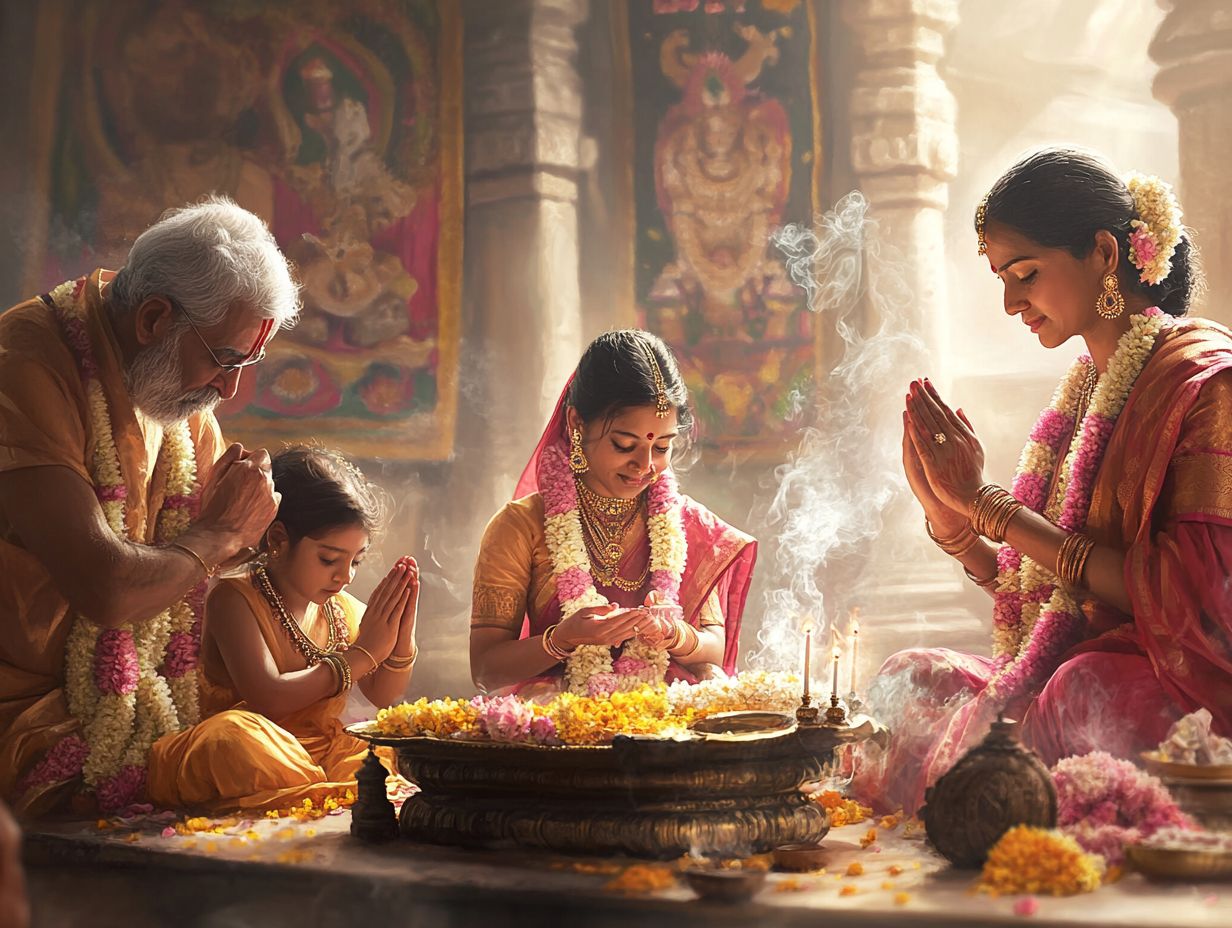What is Niyog in Hinduism?
Niyog, a term deeply embedded in ancient Hindu traditions, denotes a distinctive marital custom that permitted a woman to conceive a child with a man other than her husband, often for the purposes of lineage or to ensure viable offspring.
This article delves into the intricate dimensions of Niyog, tracing its historical origins, the significance it holds within Vedic texts, and its role in ancient society.
It examines the various types and rituals associated with Niyog, alongside the contemporary controversies and criticisms that have emerged around this practice within the context of Hindu law and societal norms.
Readers are invited to explore the complexities of Niyog and its evolution within modern Hindu society, reflecting on its cultural significance and religious customs.
What is the Meaning of Niyog?

Niyog, an ancient practice deeply embedded in Hinduism, pertains to the ceremonial act of surrogate motherhood, articulating distinct duties and responsibilities related to reproduction, marriage, familial lineage, and traditional practices.
This revered tradition, referenced in numerous Hindu scriptures such as the Vedas and Manusmriti, underscores the ethical dimensions of childbearing, including the moral dilemmas encountered within a patriarchal society and the nuances of dharma and marriage.
It also offers insight into the complex interplay of dharma and duty, which are fundamental tenets in the preservation of family honor, the continuation of lineage, and the spiritual lineage of Hindu traditions.
History and Origins of Niyog
The history and origins of Niyog extend back to ancient Hindu society, where this practice is meticulously documented in various Brahmanical texts and Hindu scriptures. These writings reveal a complex interplay of reproductive ethics, social customs, and historical context that shape family dynamics.
Such historical context elucidates how Niyog was regarded as a viable solution for childlessness, addressing the moral teachings, community obligations, and generational continuity that surround procreation and the preservation of family honor.
What are the Vedic Texts that Mention Niyog?
Niyog is prominently referenced in several significant Vedic texts, including the Manusmriti and other ancient scriptures, which delve into reproductive ethics, familial obligations, and religious law concerning childbearing and the continuation of lineage. These texts lay the groundwork for comprehending the spiritual significance and moral teachings inherent in this practice.
Within these revered writings, Niyog is frequently situated within the framework of preserving dharma, or moral duty, highlighting the importance of producing offspring to ensure the perpetuation of a family s lineage. The Mahabharata, for instance, delineates scenarios where Niyog acts as a resolution to infertility issues and family honor. Various interpretations suggest that these practices transcended mere procreation, encompassing intricate considerations of social responsibilities, ethical implications, and Hindu ethics.
The impact of such texts on societal norms remains palpable today, as they continue to shape discussions surrounding reproductive rights and responsibilities, as well as the evolving definitions of family and marriage in contemporary Indian society.
What is the Significance of Niyog in Ancient Hindu Society?
In ancient Hindu society, Niyog held considerable significance as a pragmatic solution to infertility, ensuring the continuation of family lineage and the adherence to societal roles deeply embedded in cultural heritage. This practice was intricately linked to moral values and the understanding of reproductive duties as sacred obligations.
Niyog not only reflected the community s nuanced approach to family structure but also underscored the importance of having offspring who could perpetuate rituals and uphold family legacies. By permitting a designated individual to bear children on behalf of those unable to do so, Niyog addressed the societal pressures surrounding progeny, ultimately fostering a sense of stability within families.
This practice enabled individuals to navigate their roles within the broader community while honoring the deeply rooted customs and ethical considerations of the time. The significance of Niyog transcended mere reproduction, as it cultivated bonds between families and promoted collective responsibilities that strengthened social ties.
What is the Purpose of Niyog?

The essence of Niyog lies in its commitment to facilitating procreation, thereby ensuring the perpetuation of family honor and lineage. It also navigates the societal expectations that accompany reproduction within a culturally significant framework, including religious obligations and family values.
This practice highlights the complex interplay between dharma, duty, and childbearing, positioning surrogacy as a vital avenue through which these obligations can be fulfilled, reflecting the socio-religious context of ancient Hindu society.
What are the Different Types of Niyog?
Different types of Niyog can be identified, each characterized by distinct customs surrounding surrogacy and reproductive practices. These customs have evolved from ancient traditions and reflect the diverse family structures and societal norms that have shaped them. Such classifications reveal the intricate nature of Niyog within the framework of Hindu philosophy and reproductive ethics.
In ancient periods, the practice of Niyog frequently involved a male relative serving as a sperm donor, thereby ensuring the continuation of family lineage independent of the institution of marriage. This arrangement had profound implications for societal hierarchy and inheritance, illustrating how lineage was intricately connected to social identity.
In today’s contemporary society, while many of these practices have been reshaped by advancements in reproductive technologies and shifting family dynamics, the essence of Niyog remains relevant. This persistence invites ongoing discussions about ethics, parental rights, and the very definition of family in the modern world. Such an evolution underscores the lasting impact of historical customs on contemporary reproductive strategies.
How is Niyog Practiced?
The practice of Niyog is marked by an intricate array of rituals and ceremonies, profoundly rooted in community traditions. These sacred proceedings serve to sanctify the concept of surrogate motherhood while emphasizing its spiritual importance.
They often embody age-old beliefs and the moral teachings that accompany childbearing and the continuity of family lineage, reflecting the spiritual practices and sacred duties.
What are the Rituals and Ceremonies Involved in Niyog?
The rituals and ceremonies associated with Niyog are intricately woven with profound meaning, often showcasing sacred practices that underscore the spiritual significance of surrogate motherhood and the familial values it embodies. These rituals frequently draw inspiration from ancient customs, reinforcing the cultural identity of the families involved.
The ceremony typically commences with an invocation of deities, seeking blessings to facilitate a smooth and virtuous process. Various offerings, such as grains and fruits, symbolize fertility and abundance, embodying a deep-rooted belief in divine support for this sacred undertaking.
Throughout the rituals, chants and mantras are recited, enhancing the spiritual ambiance while uniting the families in their shared purpose, fostering a sense of community and collective responsibility. These practices illuminate the concept of dharma, or righteous duty, emphasizing that such acts transcend the biological realm, deeply intertwining with the moral and ethical principles inherent in the Hindu tradition.
What are the Beliefs and Customs Surrounding Niyog?

Beliefs and customs surrounding Niyog are intricately shaped by spiritual significance and cultural interpretations that have evolved over centuries, influencing how communities perceive reproductive responsibilities and family dynamics. These beliefs often serve as a reflection of broader societal norms within the context of Hinduism.
As societal values shift over time, the understanding of Niyog has similarly transformed, adapting to contemporary views on marriage, parenthood, and communal obligations. This evolution illustrates a harmonious blend of traditional practices and modern ideologies, emphasizing the dynamic interplay between sacred beliefs and everyday life.
For many, Niyog transcends mere procreation; it embodies a deep-rooted cultural narrative that profoundly affects kinship ties, gender roles, and collective identities. The implications are significant, as communities strive to navigate the delicate balance between preserving ancient customs and embracing progressive changes in attitudes towards family and reproduction.
Controversies and Criticisms of Niyog
Niyog has not escaped scrutiny and debate, especially concerning its ethical implications and the societal norms that influence gender roles and reproductive rights within a patriarchal framework. This practice brings forth intricate questions surrounding women’s give the power toment and the moral complexities associated with surrogate motherhood.
What are the Arguments Against Niyog?
Arguments against Niyog frequently revolve around ethical concerns, particularly those related to women’s rights and the implications of surrogacy within a patriarchal framework. Critics contend that this ancient practice can lead to the objectification of women and compromise their autonomy in matters of reproductive ethics. These critiques bring to light the moral dilemmas intertwined with Niyog, also referred to as surrogate motherhood, and provoke inquiries into its relevance in contemporary society and Hinduism.
Within a landscape characterized by persistent gender inequality, detractors assert that Niyog may perpetuate damaging stereotypes and reinforce traditional gender roles, which often prioritize men’s reproductive desires at the expense of women’s rights to make independent choices. The commodification of women’s bodies, especially in contexts marked by dire socio-economic conditions, raises profound ethical questions concerning consent and coercion. The absence of robust legal protections for women involved in such arrangements often renders them vulnerable, prompting skepticism about whether these agreements genuinely reflect voluntary choices or represent a capitulation to societal pressures, religious customs, and societal norms.
As these discussions continue to evolve, the necessity for a thorough examination of reproductive ethics and religious implications in practices like Niyog becomes increasingly evident, underscoring the ongoing struggle for women’s rights and self-determination.
How Has Niyog Evolved in Modern Hindu Society?
The evolution of Niyog in modern Hindu society illustrates a significant shift in attitudes toward reproductive rights and gender equality. As communities navigate the contemporary relevance of this ancient practice, they engage in ongoing discussions about women s empowerment and the changing dynamics of family structure and cultural significance. This evolution reflects a broader societal movement toward more inclusive interpretations of reproductive ethics and marital duties.
In recent years, there has been a noticeable reevaluation of traditional customs and religious practices, with many individuals considering how these practices can harmonize with contemporary values such as informed consent and personal agency. As conversations around these topics broaden, Niyog emerges not merely as a relic of the past but as a potential framework offering valuable insights into the ongoing pursuit of gender equity and the broader context of Hindu ethics and societal expectations.
The growing recognition of women’s autonomy and their rights to make informed choices about their bodies positions Niyog within the larger narrative of reproductive rights and moral teachings. This showcases how ancient practices can adapt and evolve to align with modern principles of fairness, respect, and shared responsibility in parenting and familial roles, reflecting the evolving family dynamics and kinship structures.
Frequently Asked Questions

What is Niyog in Hinduism?
Niyog is a traditional Hindu practice where a woman is allowed to have a child with a man other than her husband, in certain circumstances. This practice is deeply rooted in ancient scriptures and Vedic texts, reflecting the cultural heritage and spiritual beliefs of Hindu society.
Is Niyog considered as adultery in Hinduism?
No, Niyog is not considered as adultery in Hinduism since it is a sanctioned practice that is mentioned in the ancient Hindu scriptures, including the Manusmriti and other sacred texts.
What are the reasons for practicing Niyog?
Niyog is typically practiced when a man is unable to have children, or if he has passed away before having children. It is also considered a way to continue the family lineage, preserve generational legacy, and fulfill familial and social responsibilities within the framework of Hindu law and religious obligations.
Who can participate in Niyog?
In Hinduism, only widows or barren women are allowed to participate in Niyog. The man chosen for the practice is usually a close relative, such as a brother-in-law or uncle, reflecting the importance of maintaining family lineage and societal norms.
What is the role of the husband in Niyog?
The husband plays an important role in Niyog as he must give permission and consent for his wife to participate. He is also responsible for taking care of the child born through Niyog as his own, ensuring the continuity of the family lineage and fulfilling his sacred duties and marital responsibilities.
Is Niyog still practiced in modern times?
Niyog is not a widely practiced tradition in modern Hindu society. It is more commonly seen in rural or conservative communities, where traditional practices and rituals of procreation are still observed within the context of ancestral worship and patriarchal society.
